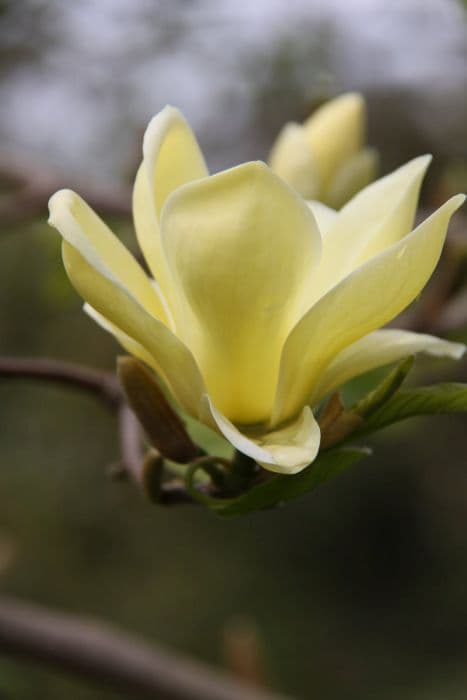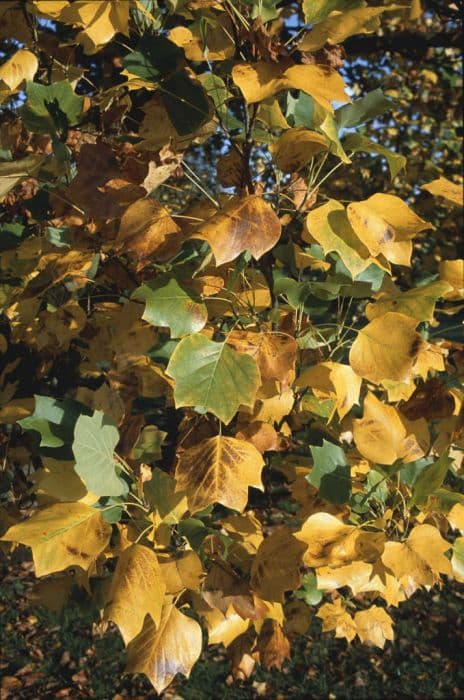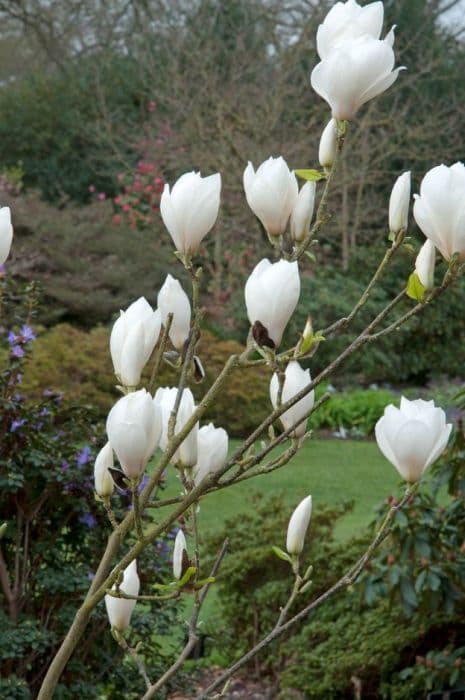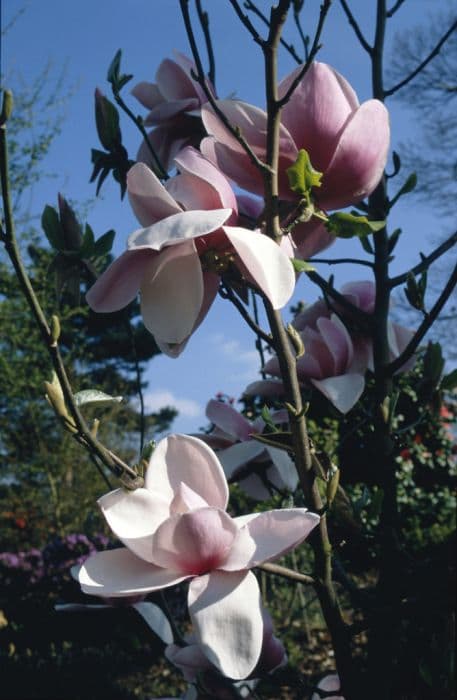Magnolia Magnolia 'Lois'

ABOUT
The Magnolia 'Lois' is a captivating plant adorned with large, showy flowers. Its blossoms are characterized by a rich, primrose yellow, lending a luminous quality to the display. The petals are thick and waxy, and they boast a cup-like shape that gently opens up into a more expansive form as the flowers mature. This particular variety of Magnolia is cherished for its stunning floral presentation, which arrives in the early spring, providing a striking contrast to the lingering grays of winter. As for the foliage, the leaves are broad and glossy with a deep green color that serves as a lush backdrop for the flowers. The texture of the leaves is smooth and they are typically elongated, coming to a point at the tip. They grow densely on the branches, creating a canopy of green throughout the summer months. The Magnolia 'Lois' overall presents an elegant yet robust appearance, with its combination of vibrant flowers and rich foliage. It is a treasured addition to any landscape for its breathtaking early bloom and colorful presence throughout the growing season.
About this plant
 Names
NamesSynonyms
Lois Magnolia
Common names
Magnolia 'Lois'.
 Toxicity
ToxicityTo humans
The Magnolia, including the 'Lois' variety, is generally considered to be non-toxic to humans. There are no commonly reported symptoms of poisoning because ingestion of parts of this plant doesn't typically result in adverse health reactions.
To pets
Magnolia trees, including the 'Lois' cultivar, are not known to be toxic to pets such as dogs and cats. If a pet were to ingest parts of this plant, it's not likely to suffer from poisoning symptoms as a result of the magnolia. However, in some cases, consuming non-food items can potentially cause gastrointestinal upset in pets.
 Characteristics
CharacteristicsLife cycle
Perennials
Foliage type
Deciduous
Color of leaves
Green
Flower color
Yellow
Height
20-25 feet (6-7.6 meters)
Spread
10-15 feet (3-4.5 meters)
Plant type
Tree
Hardiness zones
5-9
Native area
North America
Benefits
 General Benefits
General Benefits- Aesthetic Appeal: Magnolia 'Lois' features large, showy yellow flowers that add vibrant color and visual interest to landscapes.
- Seasonal Interest: This plant blooms in late spring, providing seasonal interest after many early spring bloomers have faded.
- Fragrance: The flowers emit a pleasant fragrance that can enhance the sensory experience of a garden.
- Shade Provision: With its broad canopy, the Magnolia 'Lois' can provide shade in sunny areas, creating cool spots in the garden during hot weather.
- Habitat Support: It serves as a habitat and food source for a variety of wildlife such as birds and beneficial insects.
- Low Maintenance: Once established, it generally requires minimal care, making it suitable for gardeners of all skill levels.
- Durability: This magnolia variety tends to be hardy and can withstand various climatic conditions once mature.
- Privacy Screen: Due to its dense growth habit, it can be used as a natural privacy screen in residential landscapes.
- Soil Enrichment: The fallen leaves decompose and enrich the soil with organic matter, fostering a healthy garden ecosystem.
 Medical Properties
Medical PropertiesThis plant is not used for medical purposes.
 Air-purifying Qualities
Air-purifying QualitiesThis plant is not specifically known for air purifying qualities.
 Other Uses
Other Uses- Magnolia 'Lois' petals can be crystallized with sugar and used to decorate cakes or desserts, providing an elegant and edible garnish.
- The strong, yet pliable, branches of the Magnolia 'Lois' can be woven to create natural wreaths or other forms of botanical art.
- Leaves from the Magnolia 'Lois' can be used in the creation of eco-friendly dyes, giving fabrics a soft green hue.
- The bark of the Magnolia 'Lois' can be used in small-scale landscaping as a natural and decorative mulch that will also deter weeds.
- Rich blooms of the Magnolia 'Lois' are sometimes used as a natural source of pigment for artisanal paints.
- Pressed and dried Magnolia 'Lois' flowers can be incorporated into handmade paper for a unique texture and appearance.
- The wood of Magnolia 'Lois' can be used in furniture-making, particularly for ornate pieces where the wood's fine grain is appreciated.
- During blooming season, the flowers of Magnolia 'Lois' can be a source of nectar for bees, promoting local beekeeping activities.
- Large, intact leaves of the Magnolia 'Lois' can serve as natural serving plates for outdoor or rustic-themed events.
- The scent of Magnolia 'Lois' flowers can be infused into oils or candles to create a natural, floral fragrance for the home.
Interesting Facts
 Feng Shui
Feng ShuiThe Magnolia is not used in Feng Shui practice.
 Zodiac Sign Compitability
Zodiac Sign CompitabilityThe Magnolia is not used in astrology practice.
 Plant Symbolism
Plant Symbolism- Perseverance and Endurance: Magnolias are known for their ability to survive under harsh conditions, thus they represent the ability to endure life's difficulties.
- Dignity and Nobility: With their grand appearance and long history, magnolias are often associated with elegance and a regal bearing.
- Feminine Beauty: The magnolia's exquisite and delicate blossoms are frequently symbolic of purity and the beauty of nature, often reflecting the soft and gentle side of femininity.
- Love of Nature: As a tree that's intricately linked to the natural world, magnolias epitomize a deep appreciation and love for the environment.
- Spiritual Connection: In various cultures, magnolias are seen as a symbol of spirituality and the pursuit of enlightenment due to their ethereal presence.
 Water
WaterMagnolia 'Lois', commonly known as Yellow Bird Magnolia, requires consistent moisture but does not tolerate waterlogged conditions. It should be watered deeply once a week, ensuring the soil is moist but not saturated. You can supply about 3 gallons of water for young trees each time you water to ensure it reaches deep into the root system. In periods of drought or extreme heat, increase watering frequency to twice a week. However, during the winter and in well-established trees, reduce watering since the plant will require less.
 Light
LightYellow Bird Magnolia thrives in full sun to partial shade. It performs best when it receives at least 4 hours of direct sunlight each day. An ideal spot would be where the plant is exposed to the morning sun and gets some shade during the hottest part of the afternoon to protect its delicate blooms from scorching.
 Temperature
TemperatureYellow Bird Magnolia does well in a range of temperatures but prefers a moderate climate. It can tolerate minimum temperatures down to about 0 degrees Fahrenheit, and maximum temperatures that do not exceed 100 degrees Fahrenheit. Ideally, daytime temperatures between 60 to 70 degrees Fahrenheit and cooler nighttime temperatures are optimal for this magnolia variant.
 Pruning
PruningPrune Yellow Bird Magnolia to maintain its shape, remove dead or damaged wood, and promote healthy growth. The best time to prune is late summer or early fall after flowering has finished, as this avoids cutting off the next season's blooms. Typically, this magnolia requires minimal pruning; remove only what is necessary and aim to do so every 2 to 3 years unless there is dead or damaged wood that needs immediate attention.
 Cleaning
CleaningAs needed
 Soil
SoilThe Magnolia 'Lois', commonly referred to as Lois Magnolia, thrives in a soil mix that is rich, well-draining, and slightly acidic to neutral, with a pH range of 5.5 to 7.0. A good soil mix can be created using equal parts loam, peat moss, and perlite to ensure proper drainage and aeration, which are essential for healthy root development.
 Repotting
RepottingLois Magnolia, a less frequently cultivated cultivar of Magnolia, generally does not need to be repotted often. It prefers to be left undisturbed and should only be repotted if it has outgrown its current container or if the soil has degraded significantly, which might happen every 3 to 5 years.
 Humidity & Misting
Humidity & MistingFor the Lois Magnolia, maintaining moderate to high humidity levels is beneficial, ideally between 50-60%. They can tolerate lower humidity, but in drier environments, supplementary humidity might be necessary to keep the foliage in good condition.
 Suitable locations
Suitable locationsIndoor
Place Lois Magnolia near a bright window, ensure high humidity.
Outdoor
Plant in well-draining soil, part sun, sheltered from strong winds.
Hardiness zone
5-9 USDA
 Life cycle
Life cycleThe life cycle of the Magnolia 'Lois' begins with germination, where the seed establishes itself in soil and begins to sprout. In the vegetative growth stage, the plant develops its root system, stems, and foliage, gradually maturing over several years. As it enters the flowering stage, Magnolia 'Lois' produces its characteristic large, showy, and fragrant flowers, typically in early spring before the foliage fully develops. Following pollination, often by beetles attracted to the flowers, the plant enters the fruiting stage, in which it forms seed cones that mature and release seeds. The dispersal stage occurs when seeds are spread by wind or sometimes by animals, finding new locations to grow. Throughout its lifecycle, the Magnolia 'Lois' may experience repeated cycles of growth and dormancy, annually shedding its leaves in the fall and entering a period of winter dormancy in colder climates.
 Propogation
PropogationPropogation time
Spring-Early Summer
Magnolia 'Lois', known for its beautiful blossoms and fragrant flowers, is most commonly propagated through softwood cuttings. This method is typically done in late spring to early summer, when the new growth is still flexible but mature enough to take root. Cuttings about 4 to 6 inches long with several sets of leaves are snipped from a healthy parent plant, just below a node. The lower leaves are removed, and the bottom end of the cutting is often dipped in rooting hormone to encourage root development. The prepared cutting is then placed in a well-draining growing medium, such as a mix of peat and perlite, ensuring that the node where the leaves were removed is buried. The environment should be kept humid, which can be achieved by covering the pot with a plastic bag or using a propagation dome, and the temperature should be maintained at around 70 to 75°F (21 to 24°C). With proper care and conditions, the cuttings will develop roots in several weeks and can be transplanted to individual pots or directly into the garden.









